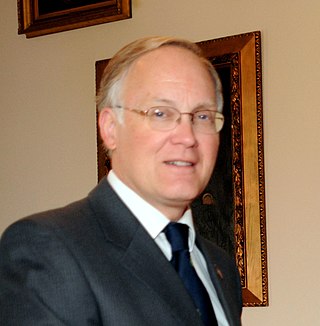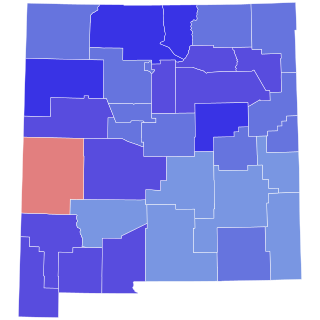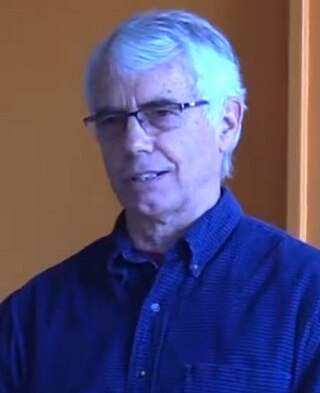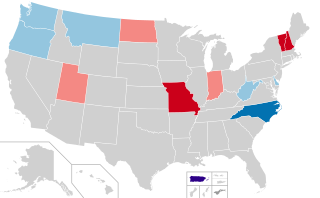
James Holley Douglas is an American politician from the state of Vermont. A Republican, he served as the 80th governor of Vermont from 2003 to 2011. On August 27, 2009, Douglas announced that he would not seek re-election for a fifth term in 2010. He left the office in January 2011.

United States gubernatorial elections were held on November 7, 2006, in 36 states and two territories. The elections coincided with the midterm elections of the United States Senate and the United States House of Representatives.

The 2006 New Mexico gubernatorial election was a race for the Governor of New Mexico held on November 7, 2006. Incumbent Democratic Governor Bill Richardson was running for re-election. He faced Republican John Dendahl in the general election and won by a landslide. As of 2023, this was the last time a male candidate was elected Governor of New Mexico.

The 2006 Oklahoma gubernatorial election was held on November 7, 2006. Incumbent Democratic Governor Brad Henry won re-election to a second term in a landslide, defeating Republican U.S. Representative Ernest Istook. Henry took 66.5% of the vote to Istook's 33.5% and swept all but three counties in the state.

The 2006 Tennessee gubernatorial election took place on November 7, 2006, to elect the governor of Tennessee, alongside other state and local elections. Incumbent Democratic Governor Phil Bredesen was re-elected to a second term with 68.6% of the vote, defeating his Republican challenger Jim Bryson. Improving on his performance from 2002, Bredesen also carried every county in the state.

The 2006 Nevada gubernatorial election was held on November 7, 2006. Incumbent Governor Kenny Guinn could not run due to term limits. Republican Congressman Jim Gibbons defeated Democratic State Senator Dina Titus. As of 2023, this is the most recent election in which Nevada voted for a gubernatorial candidate of the same party as the incumbent president.

The 2006 Wisconsin gubernatorial election was held on November 7, 2006. Incumbent Democratic Governor Jim Doyle ran for re-election to a second term in office. Doyle was unopposed in the Democratic primary, and he faced U.S. Representative Mark Green, who was unopposed in the Republican primary, in the general election. The campaign between Doyle and Green was competitive and hotly contested, but Doyle, whose approval ratings hovered around 50%, had the upper hand. In the end, Doyle defeated Green by a fairly comfortable margin, improving on his 2002 victory in the process.

The 2006 Hawaii gubernatorial election was held on November 7, 2006. Incumbent Linda Lingle was the first Republican to be elected governor of Hawaii since 1959. Although 2006 was a strong election year for Democrats, Lingle won re-election by a landslide owing to an economic rebound in the state that occurred during her tenure after a shaky decade for the state economy during the 1990s and early 2000s. As of 2024, this is the last time Republicans won a statewide election in Hawaii, as well as the only time in Hawaii history that a Republican governor was re-elected. Additionally, this alongside 1972 United States presidential election were the only two times Republicans won the state with more than 60% of the vote.

The 2006 Oregon gubernatorial election took place on November 7, 2006. Incumbent Democratic Governor of Oregon Ted Kulongoski ran for a second and final term as governor. Kulongoski faced several challengers in his primary, whom he dispatched to win his party's nomination a second time, while Republican nominee Ron Saxton, the former Chair of the Portland Public Schools Board and a candidate for governor in 2002 emerged from a crowded primary. Kulongoski and Saxton were initially going to be challenged in the general election by State Senator Ben Westlund, but Westlund withdrew his candidacy before the general election. There were multiple independent and third party challengers on the ballot as well. In a hard-fought campaign, Kulongoski won re-election by a surprisingly wide margin, winning his second term as governor.

The 2006 Wyoming gubernatorial election took place on November 7, 2006. Incumbent Democratic Governor Dave Freudenthal won re-election in a landslide over Republican Ray Hunkins, becoming the first Democrat since 1910 to win every county in the state. To date this was the last time a Democrat was elected to statewide office in Wyoming, the last time a Democrat carried every county in the state, the last gubernatorial election in which a Democrat received more than 30% of the vote, the last statewide election in which a Democrat received more than 45% of the vote, and the last statewide election in which a Democrat won any county besides Teton, Albany, Laramie, or Sweetwater. As of 2024, Ray Hunkins is the last Republican gubernatorial nominee who was never elected Governor of Wyoming. This is the last time that Wyoming voted for and elected a Senate candidate and a gubernatorial candidate of different political parties.

The 2006 United States Senate election in Vermont was held November 7, 2006. Incumbent independent Senator Jim Jeffords decided to retire rather than seek reelection to a fourth term, and Bernie Sanders was elected to succeed him.

Scudder Parker is an American Democratic politician from Vermont. He served in the Vermont State Senate for eight years.

United States gubernatorial elections were held on November 4, 2008, in 11 states and two territories. Prior to the election, eight of the total seats were held by Democrats and five by Republicans. Two governors were prohibited by term limits from seeking re-election in 2008. The only governorship to change party was the open seat in Missouri, which was won by a Democrat after being previously held by a Republican.

The 2008 Vermont gubernatorial election took place on November 4. Incumbent Republican Governor Jim Douglas won re-election to a fourth term. The gubernatorial primary took place on September 9, 2008.

The 2010 Vermont gubernatorial general election took place on November 2. Vermont and New Hampshire are the only two states where the governor serves a two-year term instead of four. Primary elections took place on August 24.

United States gubernatorial elections were held on November 8, 2016, in 12 states and two territories. The last regular gubernatorial elections for nine of the 12 states took place in 2012. The last gubernatorial elections for New Hampshire, Oregon, and Vermont took place in 2014, as Oregon held a special election due to the resignation of Governor John Kitzhaber, while the governors of New Hampshire and Vermont both serve two-year terms. The 2016 gubernatorial elections took place concurrently with several other federal, state, and local elections, including the presidential election, Senate, and House elections.

The 2018 Vermont gubernatorial election took place on November 6, 2018, to elect the Governor of Vermont, concurrently with the election of Vermont's Class I U.S. Senate seat, as well as other elections to the United States Senate in other states and elections to the United States House of Representatives and various state and local elections. Incumbent Republican Governor Phil Scott, who was first elected in 2016, was re-elected to a second term in office. Hallquist's 40.3% was also the worst performance for a Democratic Party candidate since 2008. This was one of eight Republican-held governorships up for election in a state that Hillary Clinton won in the 2016 presidential election.

United States gubernatorial elections were held on November 3, 2020, in 11 states and two territories. The previous gubernatorial elections for this group of states took place in 2016, except in New Hampshire and Vermont where governors only serve two-year terms. These two states elected their current governors in 2018. Nine state governors ran for reelection and all nine won, while Democrat Steve Bullock of Montana could not run again due to term limits and Republican Gary Herbert of Utah decided to retire at the end of his term.

United States gubernatorial elections were held on November 8, 2022, in 36 states and three territories. As most governors serve four-year terms, the last regular gubernatorial elections for all but two of the seats took place in the 2018 U.S. gubernatorial elections. The gubernatorial elections took place concurrently with several other federal, state, and local elections, as part of the 2022 midterm elections.

The 2022 Vermont gubernatorial election was held on November 8, 2022, to elect the governor of Vermont. Incumbent Republican governor Phil Scott won re-election to a fourth term in a landslide, defeating Democratic nominee Brenda Siegel.
























